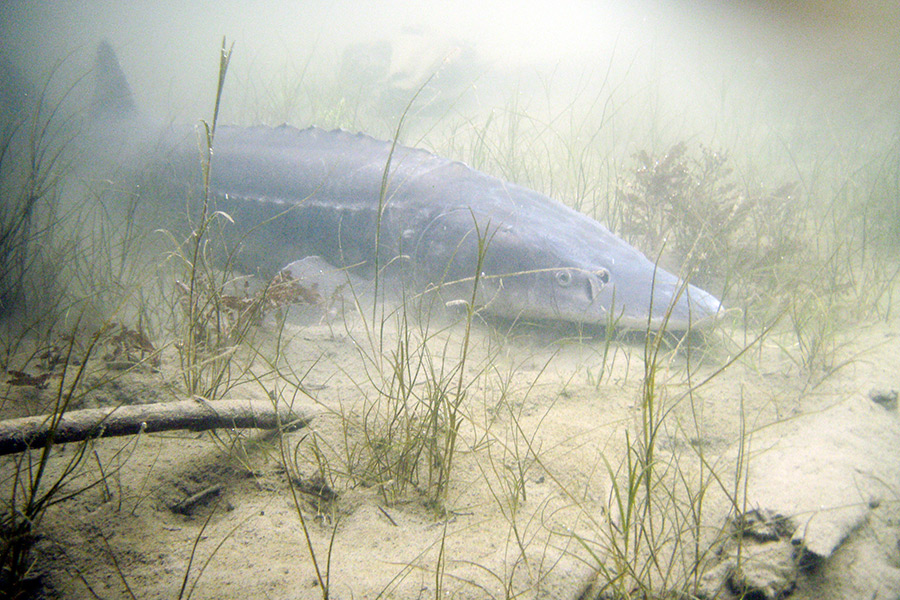The wild Kootenai River white sturgeon is a toothless behemoth from the days of the dinosaurs that can live to be 100 years old, a prehistoric specimen characterized by its large head, vacuum-like nose used for sucking up prey, armor-like scales, and colossal size – it can reach 19 feet long and weigh more than a ton.
The largest freshwater fish in North America has inhabited Montana’s lakes and rivers for eons, but at the end of the last Ice Age, roughly 11,000 years ago, the retreating glaciers created a waterfall known as Bonnington Falls on the west arm of Kootenay Lake, located in British Columbia, upstream of where the Kootenai River flows into the Columbia River.
Because the falls created a hydrologic roadblock, the fish above the falls could no longer migrate to the Pacific Ocean, creating the first naturally landlocked white sturgeon population in North America.
The Kootenai River white sturgeon adapted, with historic estimates pegging the population of the bottom-feeding beasts at between 7,000 and 9,000 adults.
As the landscape was settled and the sturgeon’s natural surroundings were altered by dams and dikes the fish lost critical habitat, and in 1994 white sturgeon in the Kootenai River basin of Montana and Idaho were listed as endangered under the federal Endangered Species Act.
At the time, scientists estimated that only a handful of white sturgeon still swam in Montana’s portion of the Kootenai River.
To satisfy the requirements of the Endangered Species Act, the fish would have to reproduce naturally before it is considered recovered, which is a difficult charge given that it takes 20 or 30 years for white sturgeon to mature and begin reproducing.
Since 1995, Idaho’s Kootenai Tribe of Indians has stocked the river with thousands of hatchery-raised sturgeon in an attempt to fill the vacuum created as older fish die off.
The experimental spawning efforts have released hundreds of thousands of juvenile white sturgeon between 1 and 2 years old and millions of embryos into the Kootenai River and Kootenay Lake. Of those sturgeon, Montana has received roughly 30,000, but survival of juvenile sturgeon from the hatchery averages just 20 percent in the first year at large, and 84 percent after age 3.
That means that if 1 million juvenile sturgeon are stocked into the Kootenai River, roughly 5,000 to 10,000 will make it to age 30, said Ryan Sylvester, a biologist with Montana Fish, Wildlife and Parks’ Libby office.
“The 1995 class of sturgeon is just now approaching reproductive maturity, so if the remaining wild adults blink out, and the first juveniles are just now reaching maturity, it’s unknown whether the hatchery sturgeon will be able to reproduce at levels high enough to sustain the population,” he said.
White sturgeon captured in Montana since 2009 ranged from 20 to 46 inches, and Sylvester’s current estimate of adult white sturgeon in Montana is about 200 fish, which represents a small portion of the total number of wild and hatchery adult fish in the Kootenai River and Kootenay Lake.
Sylvester said sturgeon have become so rare that he often speaks to people who don’t realize such an extraordinary fish exists in Montana’s rivers and lakes.
“I tell people that these prehistoric fish can grow to be up to nine-and-a-half-feet long and they’re blown away,” he said.
In 1968, angler Herb Stout caught a sturgeon that weighed 96 pounds and measured 72 inches, setting a state record that still stands. In 2013 an adult sonic-tagged sturgeon was detected downstream of the Yaak River and measured at 87 inches, but no weight information was recorded.
“It might have been bigger than the current state record, but we won’t know unless we catch her again and collect the weight information,” Sylvester said. “We do know there are remaining adults in the river and the lake, but we haven’t caught one in seven years of sampling.”
The fish are a living relic of Montana, Sylvester said, and its recovery is too precious to give up on. But if the juveniles don’t begin replacing the adults at a greater rate than they are dying out, prospects of recovery are bleak.
“The species is definitely not out of the woods, and the next 15 years will tell us a lot,” Sylvester said. “I don’t know if anything is going to change dramatically in the near future. If it did it would be a huge event.”
